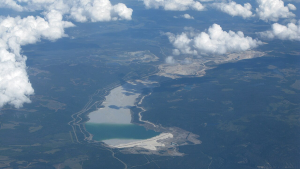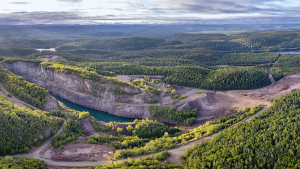As water levels sink toward an all-time low, researchers are trying to pinpoint the cause of the freshwater corrosion.
Steel piles at risk of collapse due to holes
DULUTH, Minn.
Commercial dock owners on Lake Superior are seeing something new as lake levels sink toward an all-time low — and many don’t like what they see.
An aggressive form of corrosion has eaten away at steel that girds the port’s working shoreline, and some pilings have so many holes that they’re on the verge of failure. Researchers are trying to pinpoint the cause of the freshwater corrosion.
Chad Scott, owner of AMI Consulting Engineers of Duluth, said perforations affect most sheet piling with an original thickness of 3/8 of an inch or less that has been in the harbour for more than 30 years.
Most 3/8-inch docks probably will face collapse in the next five to 10 years unless their steel pilings are replaced, he said.
The steel piles became more visible as Lake Superior fell 18 inches from its average historical level. Dramatic corrosion can be seen on U.S. Coast Guard range towers near the Bong Bridge and at the foot of the Duluth Missabe & Iron Range Railway ore docks, operated by Canadian National.
Wooden structures are affected too, Scott said. Metal drift pins and bolts that hold together wooden cribbing in older parts of the port are failing because of corrosion.
Scott advises dock owners to have their facilities inspected.
Randall Hicks, a biology professor at the University of Minnesota Duluth, is investigating how microbes affect corrosion in the harbor. He has been studying a sampling of organisms found on the port’s steel pilings and has successfully isolated two types of bacteria that could be of interest. One appears to be an iron oxidizer and the other an iron reducer.
“We have some interesting preliminary results, but it’s way too early to tell if these bacteria are culprits,” Hicks said.
Hicks has funding to support two years of research. He’ll will study DNA samples and collaborate with Brenda Little, a scientist at the Naval Research Center in Biloxi, Miss., who specializes in scanning electron microscopy.
Scott, meanwhile, conducted dive surveys and will continue looking through the data he collected.
“We already have mounds of data, and this year we need to go through and look for trends and anomalies,” he said. “We have to plot out the data and look for patterns.”
Scott said there seems to be little issue with steel structures in the lake, but he has found evidence of accelerated corrosion upstream in the St. Louis River. He also discovered evidence of pitting at the Oliver Bridge and also at the Thomson dam. It’s unclear whether there’s a similar problem further upstream.
Scott said he believes most of the <0x00BD>-inch thick docks can still be saved.
Jim Sharrow, facilities manager for the Duluth Seaway Port Authorities, likes that news. Sharrow estimated it would cost about $20 million if he had to replace the <0x00BD>-inch thick steel pilings he oversees.
Sharrow hopes to apply protective coatings to existing steel structures to stop corrosion while researchers continue to look for answers.
“It feels like we’re in a boat drifting toward the edge of a waterfall, and we’re getting closer and closer to the edge,” he said. “Sometimes it’s difficult to have patience, but we need to go through this process.”
Associated Press










Recent Comments
comments for this post are closed